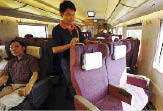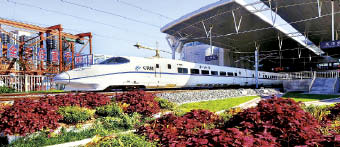Background
Inter-city Express Railway links Beijing-Tianjin
(Enorth.com.cn)
Updated: 2010-06-01 11:28
 |
Large Medium Small |

Beijing-Tianjin Inter-city Express Railway, the fastest of its kind in service in the world, began its operation on August 1, 2008, making possible the urban agglomeration of Beijing and Tianjin, which are the only pair of megalopolises in the world with a straight-line distance of about 100 kilometers. The express railway shortens the time of city commuting to only half an hour.
The speed of the railway is designed at 300 kilometers per hour, with the peak speed reaching 350 kilometers per hour. It deserves the title of China's first express railway in the real sense.

Beijing and Tianjin, two big municipalities of North China, sit at the center of the circum-Bohai Bay area, one of the fastest developing and most dynamic regions of China. At present, there are more than 30 million people living in these two cities, among whom 28 million are permanent residents. Since the two cities are the core of the circum-Bohai Bay economic rim, there is an urgent demand for the two cities to complement each other with their respective strengths.
In the past, Beijing and Tianjin were mainly connected through one railway and one two-way expressway with four lanes. It is obvious that they were unable to meet the demand of social and economic development and therefore hampered the cooperation between the two cities. It was also not convenient for people to travel around. To solve the problem, Beijing and Tianjin reached an agreement several years ago, determined to build express railway, expressway and airport to tackle the traffic problem and enhance the connection between each other.
Beijing-Tianjin Inter-city Express Railway kicked off construction on July 4, 2005 and the construction was completed on December 16, 2007, with the length of 120 kilometers and stations alongside including South Beijing, Yizhuang, Wuqing, Tianjin and Yongle. The last stop is a reserved one. The traffic time between Beijing and Tianjin is approximately 30 minutes, with the shortest running interval of three minutes.
On September 24th, 2008, a Beijing-Tianjin Inter-City Express Railway pulled in at Tianjin Tanggu Railway Station, which marked the establishment of a direct link between Beijing Southern Railway Station and Tianjin Binhai New Area.
The operation of the railway has created the most convenient "Half-An-Hour-Traffic Rim" connecting Beijing and Tianjin, two municipalities of China, making the trip shorter, faster and more comfortable. The railway will play an important role in enhancing exchange of human resources and accelerating the regional economic integration between the two cities, and promoting the favorable social and economic development around Circum-Bohai Bay Area.
In the year 2010, Beijing and Tianjin will have "seamless traffic link" with Tianjin subway line 2, 3 and 9, Beijing-Tianjin Inter-City Express Railway and Beijing subway line 4 and 14 functioning together. At that time, taking subway and railway will be the most speedy and convenient transport method for residents traveling between the two cities.
The railway not only accelerates the agglomeration and integration of the two municipalities, but also opens a new stage for China's express railway construction.
Beijing-Tianjin Inter-City Express Railway is the first inter-city express railway in operation in Medium- and Long-Term Railway Network Plan and an important component of inter-city track transportation network of circum-Bohai Bay area. According to the network plan, by 2010, China's railway in operation will surpass 90,000 kilometers; special railway lines for trains running over 200 kilometers per hour will reach 7,000 kilometers and fast passenger transport lines will total at 20,000 kilometers.
Upon the completion of Beijing-Tianjin, Beijing-Shanghai and Beijing-Guangzhou Express Railways, the circum-Bohai Bay economic circle, the Yangtze Delta economic circle and Pearl River economic circle will be connected, involving a population of approximately 800 million.